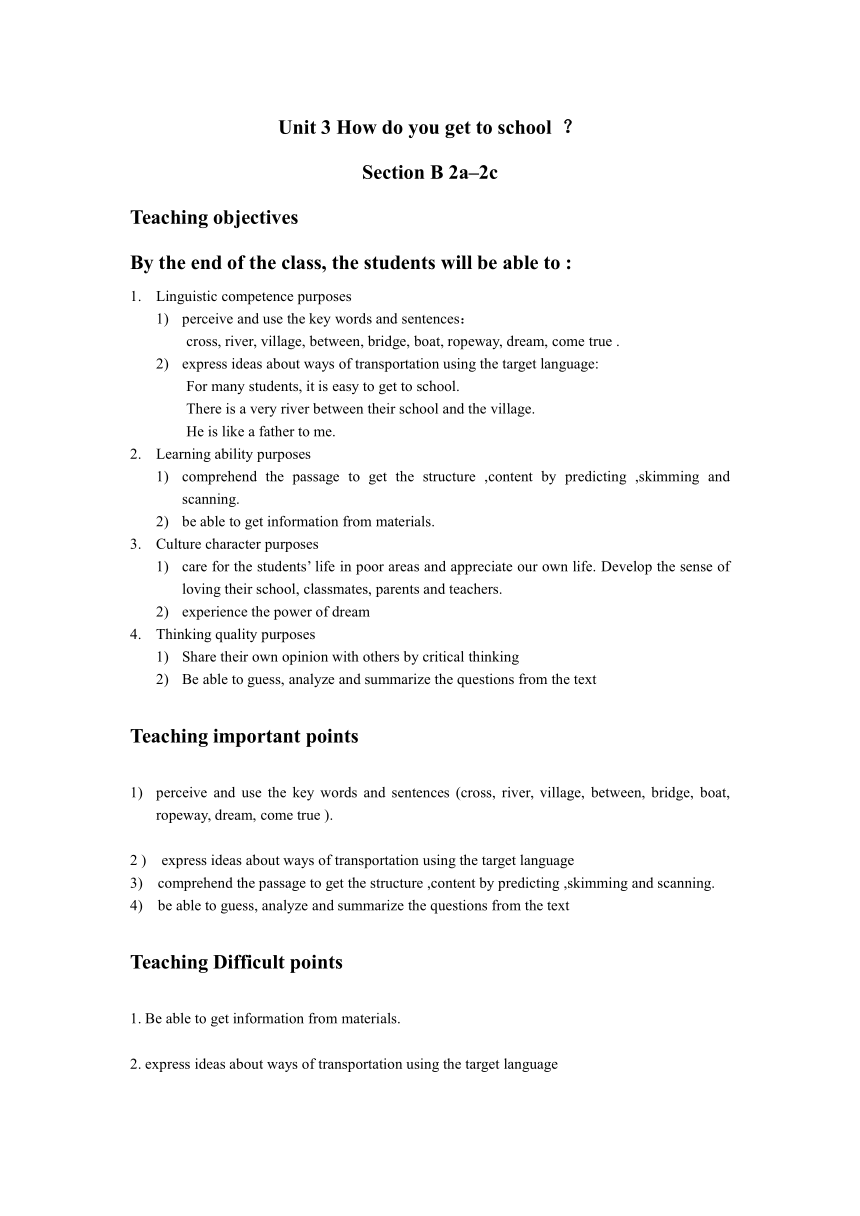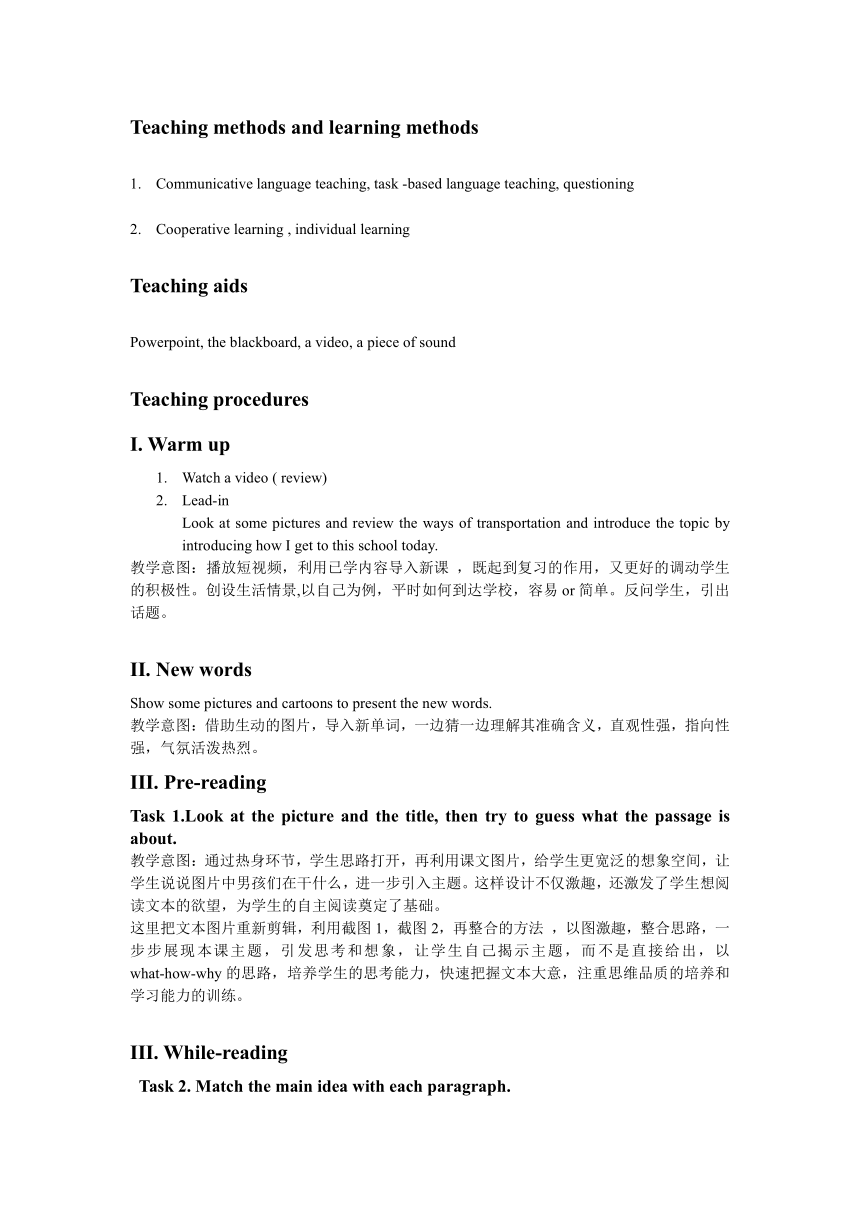人教新目标(Go for it)版七年级下Unit 3 How do you get to school? Section B 2a–2c教案
文档属性
| 名称 | 人教新目标(Go for it)版七年级下Unit 3 How do you get to school? Section B 2a–2c教案 |  | |
| 格式 | docx | ||
| 文件大小 | 43.2KB | ||
| 资源类型 | 教案 | ||
| 版本资源 | 人教新目标(Go for it)版 | ||
| 科目 | 英语 | ||
| 更新时间 | 2022-03-20 17:09:53 | ||
图片预览


文档简介
Unit 3 How do you get to school ?
Section B 2a–2c
Teaching objectives
By the end of the class, the students will be able to :
Linguistic competence purposes
perceive and use the key words and sentences:
cross, river, village, between, bridge, boat, ropeway, dream, come true .
express ideas about ways of transportation using the target language:
For many students, it is easy to get to school.
There is a very river between their school and the village.
He is like a father to me.
Learning ability purposes
comprehend the passage to get the structure ,content by predicting ,skimming and scanning.
be able to get information from materials.
Culture character purposes
care for the students’ life in poor areas and appreciate our own life. Develop the sense of loving their school, classmates, parents and teachers.
experience the power of dream
Thinking quality purposes
Share their own opinion with others by critical thinking
Be able to guess, analyze and summarize the questions from the text
Teaching important points
perceive and use the key words and sentences (cross, river, village, between, bridge, boat, ropeway, dream, come true ).
2 ) express ideas about ways of transportation using the target language
3) comprehend the passage to get the structure ,content by predicting ,skimming and scanning.
4) be able to guess, analyze and summarize the questions from the text
Teaching Difficult points
1. Be able to get information from materials.
2. express ideas about ways of transportation using the target language
Teaching methods and learning methods
Communicative language teaching, task -based language teaching, questioning
Cooperative learning , individual learning
Teaching aids
Powerpoint, the blackboard, a video, a piece of sound
Teaching procedures
I. Warm up
Watch a video ( review)
Lead-in
Look at some pictures and review the ways of transportation and introduce the topic by introducing how I get to this school today.
教学意图:播放短视频,利用已学内容导入新课 ,既起到复习的作用,又更好的调动学生的积极性。创设生活情景,以自己为例,平时如何到达学校,容易or简单。反问学生,引出话题。
II. New words
Show some pictures and cartoons to present the new words.
教学意图:借助生动的图片,导入新单词,一边猜一边理解其准确含义,直观性强,指向性强,气氛活泼热烈。
III. Pre-reading
Task 1.Look at the picture and the title, then try to guess what the passage is about.
教学意图:通过热身环节,学生思路打开,再利用课文图片,给学生更宽泛的想象空间,让学生说说图片中男孩们在干什么,进一步引入主题。这样设计不仅激趣,还激发了学生想阅读文本的欲望,为学生的自主阅读奠定了基础。
这里把文本图片重新剪辑,利用截图1,截图2,再整合的方法 ,以图激趣,整合思路,一步步展现本课主题,引发思考和想象,让学生自己揭示主题,而不是直接给出,以what-how-why的思路,培养学生的思考能力,快速把握文本大意,注重思维品质的培养和学习能力的训练。
III. While-reading
Task 2. Match the main idea with each paragraph.
教学意图:通过设计这些问题,帮助学生理解作者写作意图,以及搜索关键信息skimming的能力。在此过程中,教师有意传授阅读策略,学生对整篇文章的框架有一个初步的认知,为接下来的分段阅读做铺垫。
Task 3 Careful reading
Para.1 It’s —— for the students in the village to get to school.
Why
There is a very big river between their school and the village.
Ask students to read the questions first and read paragraph 1 aloud. Then answer the questions.
Para.2 Liangliang crosses the river every school day but he is not ——.
Does the boy love his school Why
Ask students to read paragraph 2.
And encourage another student to try to read better. (student A pk student B, who is better )
Para.3 Many of the students and villagers have a dream.
What is the villagers’ dream
Do you think their dream can come true Why
教学意图:读中环节使用了多种阅读策略(skimming, scanning), 多种读中问题的设置增加教学多样性,基于文本设计的各活动生生(问答、pk、师生交流对话),有利于学生对文本的把握和发展。在问答环节,设置为以问题为导向的对话情境,增加语言运用的真实性,及时发现语用问题并给予纠正。通过不断反问和追问,让学生探究问题,思考问题,定位关键信息,使学生感知、体验、运用语言,培养学生的语言能力和学习能力,以达到教学目的。
IV. Post- reading
Task 4 Exercise
Read again and fill in the blanks.
教学意图:读后巩固环节,让学生对文章内容再次回顾,及时复习检测阅读效果,回忆关键信息,构建信息脉络,形成思维导图。看似只是完成词语填空练习,实则让学生进一步熟悉并掌握文本中重要的句子,为读后的文本复述作准备。让学生进一步感受到农村孩子上学不易,不怕苦的精神,从而珍惜自己目前的生活。
Task 5 Look and say
Show some pictures and ask students to describe them with target language.
教学意图:学生根据图片说句子。相比较读前活动中,要求学生看图片说自己的所见,本环节对学生的语言运用提出了更高的要求。
提供inferences 进行语言输出,对语言的输入进行巩固。用自己的语言retell,加强重点句式的练习,重新整合文本,养成学生理性表达自己的思想和观点的习惯。
Task 6 Discussion
Talk about yourself
How do you get to school Is it easy
What do you think of your school, your teachers and your classmates
What is your dream
教学意图:这里进一步发展文本内容,由文本回归到生活,利用语言为表达自我服务,有利于学生对知识的掌握,培养思辨能力和语言能力。
Task 7 Report show
Ask some students to present their story.
教学意图:提供图片inferences 进行语言输出,让学生有话可讲,有章可循,从而锻炼学生的语言组织和口语表达能力,突出核心素养要求下的语言能力培养。
Emotional education
Show two pictures of their school, and some pictures of the “ice boy” Wang Fuman in poor areas, then ask students to tell his story briefly with the target language.
Educate students to appreciate their life and care for the students’ life in poor areas. Educate students to love their school, classmates, parents and teachers.
教学意图:图片展示的是前段时间的热点话题“冰花男孩”,他上学难,上学远,上学路上渴了喝路边的小溪水,梦想成为一名警察。时事新闻话题主人公贴合文章主题,由此让学生将自己的经历和贫困地区孩子上学条件对比,引发思考,懂得珍惜生活,热爱学习,热爱学校。由生活联系文本,文本回归生活实际,让学生学会感激身边老师,同学,父母和环境,体会困境中的孩子的勇敢和爱学习的精神,培养学生家国天下的情怀,以达到语言输出、情感教育和文本再升华的教学目的, 提升学生的文化品质和思维品质。
V. Summary &Homework
Summary
Together with the students, the teacher lead ss to make a summary.
Homework
Read the passage again and retell the story.
Master the words and use them to make sentences.
教学意图:课后作业是对文章内容的延伸和巩固,需要更具体,可操作。鼓励每个学生实践自己的所思所学。并结合本单元话题相互交流,灵活使用所学语言。
VI. The design of the blackboard
Unit3 How do you get to school Section B 2a-2c
Crossing the river Review: Train, boat, bus, car Words: cross, bridge, village, boat ,ropeway Sentences : It’s …for…to do sth. There is… between … and … It’s one’s dream to… Which group is the best
(Thanks for your listening.)
Section B 2a–2c
Teaching objectives
By the end of the class, the students will be able to :
Linguistic competence purposes
perceive and use the key words and sentences:
cross, river, village, between, bridge, boat, ropeway, dream, come true .
express ideas about ways of transportation using the target language:
For many students, it is easy to get to school.
There is a very river between their school and the village.
He is like a father to me.
Learning ability purposes
comprehend the passage to get the structure ,content by predicting ,skimming and scanning.
be able to get information from materials.
Culture character purposes
care for the students’ life in poor areas and appreciate our own life. Develop the sense of loving their school, classmates, parents and teachers.
experience the power of dream
Thinking quality purposes
Share their own opinion with others by critical thinking
Be able to guess, analyze and summarize the questions from the text
Teaching important points
perceive and use the key words and sentences (cross, river, village, between, bridge, boat, ropeway, dream, come true ).
2 ) express ideas about ways of transportation using the target language
3) comprehend the passage to get the structure ,content by predicting ,skimming and scanning.
4) be able to guess, analyze and summarize the questions from the text
Teaching Difficult points
1. Be able to get information from materials.
2. express ideas about ways of transportation using the target language
Teaching methods and learning methods
Communicative language teaching, task -based language teaching, questioning
Cooperative learning , individual learning
Teaching aids
Powerpoint, the blackboard, a video, a piece of sound
Teaching procedures
I. Warm up
Watch a video ( review)
Lead-in
Look at some pictures and review the ways of transportation and introduce the topic by introducing how I get to this school today.
教学意图:播放短视频,利用已学内容导入新课 ,既起到复习的作用,又更好的调动学生的积极性。创设生活情景,以自己为例,平时如何到达学校,容易or简单。反问学生,引出话题。
II. New words
Show some pictures and cartoons to present the new words.
教学意图:借助生动的图片,导入新单词,一边猜一边理解其准确含义,直观性强,指向性强,气氛活泼热烈。
III. Pre-reading
Task 1.Look at the picture and the title, then try to guess what the passage is about.
教学意图:通过热身环节,学生思路打开,再利用课文图片,给学生更宽泛的想象空间,让学生说说图片中男孩们在干什么,进一步引入主题。这样设计不仅激趣,还激发了学生想阅读文本的欲望,为学生的自主阅读奠定了基础。
这里把文本图片重新剪辑,利用截图1,截图2,再整合的方法 ,以图激趣,整合思路,一步步展现本课主题,引发思考和想象,让学生自己揭示主题,而不是直接给出,以what-how-why的思路,培养学生的思考能力,快速把握文本大意,注重思维品质的培养和学习能力的训练。
III. While-reading
Task 2. Match the main idea with each paragraph.
教学意图:通过设计这些问题,帮助学生理解作者写作意图,以及搜索关键信息skimming的能力。在此过程中,教师有意传授阅读策略,学生对整篇文章的框架有一个初步的认知,为接下来的分段阅读做铺垫。
Task 3 Careful reading
Para.1 It’s —— for the students in the village to get to school.
Why
There is a very big river between their school and the village.
Ask students to read the questions first and read paragraph 1 aloud. Then answer the questions.
Para.2 Liangliang crosses the river every school day but he is not ——.
Does the boy love his school Why
Ask students to read paragraph 2.
And encourage another student to try to read better. (student A pk student B, who is better )
Para.3 Many of the students and villagers have a dream.
What is the villagers’ dream
Do you think their dream can come true Why
教学意图:读中环节使用了多种阅读策略(skimming, scanning), 多种读中问题的设置增加教学多样性,基于文本设计的各活动生生(问答、pk、师生交流对话),有利于学生对文本的把握和发展。在问答环节,设置为以问题为导向的对话情境,增加语言运用的真实性,及时发现语用问题并给予纠正。通过不断反问和追问,让学生探究问题,思考问题,定位关键信息,使学生感知、体验、运用语言,培养学生的语言能力和学习能力,以达到教学目的。
IV. Post- reading
Task 4 Exercise
Read again and fill in the blanks.
教学意图:读后巩固环节,让学生对文章内容再次回顾,及时复习检测阅读效果,回忆关键信息,构建信息脉络,形成思维导图。看似只是完成词语填空练习,实则让学生进一步熟悉并掌握文本中重要的句子,为读后的文本复述作准备。让学生进一步感受到农村孩子上学不易,不怕苦的精神,从而珍惜自己目前的生活。
Task 5 Look and say
Show some pictures and ask students to describe them with target language.
教学意图:学生根据图片说句子。相比较读前活动中,要求学生看图片说自己的所见,本环节对学生的语言运用提出了更高的要求。
提供inferences 进行语言输出,对语言的输入进行巩固。用自己的语言retell,加强重点句式的练习,重新整合文本,养成学生理性表达自己的思想和观点的习惯。
Task 6 Discussion
Talk about yourself
How do you get to school Is it easy
What do you think of your school, your teachers and your classmates
What is your dream
教学意图:这里进一步发展文本内容,由文本回归到生活,利用语言为表达自我服务,有利于学生对知识的掌握,培养思辨能力和语言能力。
Task 7 Report show
Ask some students to present their story.
教学意图:提供图片inferences 进行语言输出,让学生有话可讲,有章可循,从而锻炼学生的语言组织和口语表达能力,突出核心素养要求下的语言能力培养。
Emotional education
Show two pictures of their school, and some pictures of the “ice boy” Wang Fuman in poor areas, then ask students to tell his story briefly with the target language.
Educate students to appreciate their life and care for the students’ life in poor areas. Educate students to love their school, classmates, parents and teachers.
教学意图:图片展示的是前段时间的热点话题“冰花男孩”,他上学难,上学远,上学路上渴了喝路边的小溪水,梦想成为一名警察。时事新闻话题主人公贴合文章主题,由此让学生将自己的经历和贫困地区孩子上学条件对比,引发思考,懂得珍惜生活,热爱学习,热爱学校。由生活联系文本,文本回归生活实际,让学生学会感激身边老师,同学,父母和环境,体会困境中的孩子的勇敢和爱学习的精神,培养学生家国天下的情怀,以达到语言输出、情感教育和文本再升华的教学目的, 提升学生的文化品质和思维品质。
V. Summary &Homework
Summary
Together with the students, the teacher lead ss to make a summary.
Homework
Read the passage again and retell the story.
Master the words and use them to make sentences.
教学意图:课后作业是对文章内容的延伸和巩固,需要更具体,可操作。鼓励每个学生实践自己的所思所学。并结合本单元话题相互交流,灵活使用所学语言。
VI. The design of the blackboard
Unit3 How do you get to school Section B 2a-2c
Crossing the river Review: Train, boat, bus, car Words: cross, bridge, village, boat ,ropeway Sentences : It’s …for…to do sth. There is… between … and … It’s one’s dream to… Which group is the best
(Thanks for your listening.)
同课章节目录
- Unit 1 Can you play the guitar?
- Section A
- Section B
- Unit 2 What time do you go to school?
- Section A
- Section B
- Unit 3 How do you get to school?
- Section A
- Section B
- Unit 4 Don't eat in class.
- Section A
- Section B
- Unit 5 Why do you like pandas?
- Section A
- Section B
- Unit 6 I'm watching TV.
- Section A
- Section B
- Review of Units 1-6
- Unit 7 It's raining!
- Section A
- Section B
- Unit 8 Is there a post office near here?
- Section A
- Section B
- Unit 9 What does he look like?
- Section A
- Section B
- Unit 10 I'd like some noodles.
- Section A
- Section B
- Unit 11 How was your school trip?
- Section A
- Section B
- Unit 12 What did you do last weekend?
- Section A
- Section B
